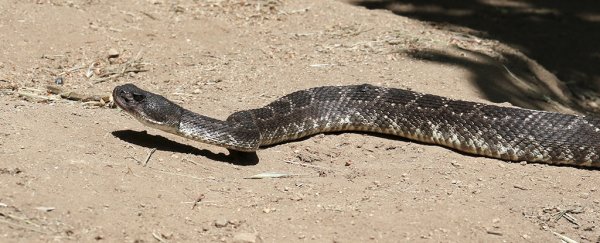A Texas man narrowly survived a venomous rattlesnake sinking its fangs into him - after he had already decapitated it with a shovel.
According to local news station KIII-TV, Jennifer Sutcliffe and her husband Jeremy were working in their yard in Corpus Christi, South Texas on the weekend of May 27. While weeding, she spotted the snake, a western diamondback rattlesnake - and to protect her, Jeremy quickly used a shovel to chop off its head.
However, when he bent over to retrieve the pieces to dispose of them, the decapitated head struck, pumping him full of deadly venom.
"The head actually turned around and grabbed onto his hand. He had to rip the snake's head off," Jennifer told Global News. "He got all of the snake's venom in the bite."
The bite of the western diamondback rattlesnake is particularly nasty and potentially lethal. It contains components that induce coagulation, which can cause blood clots to shut down the kidneys.
It also ruptures red blood cells, causing internal bleeding, damages muscles, and blisters and necrotises the tissue around the bite location. If untreated, the mortality rate of a western diamondback rattlesnake bite is around 10-20 percent.
But Jeremy Sutcliffe's case was unusually severe. Although his partner immediately started driving him to hospital, after just two miles he began having seizures, losing his vision and losing consciousness, she said.
He had to be airlifted to hospital, where he was put into an induced coma on a ventilator while hospital staff mixed the antivenom.
"They were loading him with heavy amounts of fluids and his blood pressure bottoming out," Jennifer said. "His body was going into septic shock, his organs were shutting down, and he was bleeding internally."
He ended up requiring 26 doses of antivenom before he stabilised. Usually, only a maximum of four doses is required.
But, you might be wondering, how the heck do you get bitten by a decapitated snake? Surprisingly easily, as it turns out.
Warm-blooded animals such as mammals generate heat inside our bodies, which requires a lot of energy and oxygen. If you cut off the oxygen supply, cell death follows behind pretty rapidly.
Snakes and other cold-blooded animals such as fish and amphibians, on the other hand, don't thermoregulate internally, instead relying on outside sources for warmth. Because their bodies aren't generating their own heat, their energy and oxygen requirements are lower.
This is how some cold-blooded, or ectothermic, animals are able to survive conditions without oxygen for periods of time.
And it's why snakes (and other reptiles) continue to move after being bisected. As seen in the below video, the body will reflexively writhe for a time after being cut off the brain - but the head itself can remain "alive", and likely on the defensive because of the pain of being chopped. It will attempt to bite whatever it can - even its own wriggling body.

And bites from severed snake heads have happened many times before, because people assume that the snake is dead and can't harm them. In 2014, an Australian man was bitten by a snake 45 minutes after he had cut it in half.
And, in 2007, in a case shockingly similar to Sutcliffe's, a Washington man got bitten by a rattlesnake after he severed its head with a shovel, then went to pick up the pieces. When he touched the head, the snake struck.
Both those men survived, but it doesn't always end so happily. In 2015, a chef in China was making a dish out of a spitting cobra. He had beheaded the animal 20 minutes earlier, and ended up bitten and killed.
According to the US Forest Service's snake safety guidelines, one should never handle a freshly killed snake for just this reason.
Jeremy Sutcliffe pulled through, and was brought out of his coma on May 31; sadly he also suffered acute kidney failure, and currently requires dialysis - but he lives to tell the tale.
